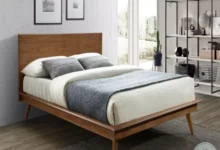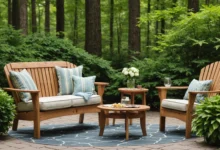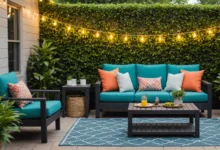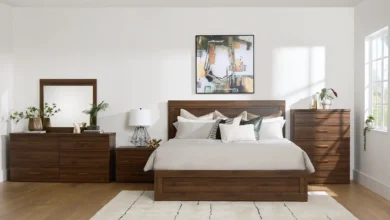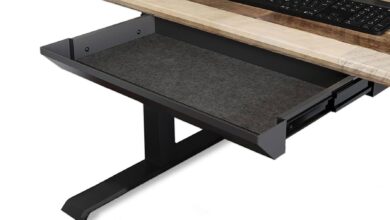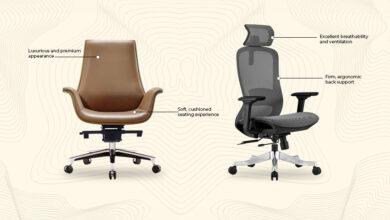Compact Patio Furniture: Small Spaces, Big Style
Small patios and balconies often crave a touch of stylish comfort, but finding the right furniture can feel like a tricky balancing act. Space is at a premium, yet you still want pieces that are attractive, durable, and inviting. This guide explores a range of compact patio furniture options, from cleverly designed sets to individual pieces perfect for adding a pop of personality to your outdoor space.
Contents
- 1 Decoding the Tiny-But-Mighty World of Small Patio Furniture
- 2 Understanding Your Space: Sizing Up Your Patio
- 3 Material Matters: Durability Meets Style
- 4 The Power of Proportions: Balancing Size and Functionality
- 5 Shape and Style: From Bistro to Cozy Corner
- 6 Choosing the Perfect Colors and Patterns
- 7 Seating Smart: Maximizing Comfort
- 8 Adding the Finishing Touches: Lighting and Accessories
- 9 Accessorize with Intention: Creating the Perfect Ambiance
- 10 Budgeting and Shopping Wisely
- 11 Choosing the Right Size and Shape for Your Space
- 12 Material Matters: Durability and Style
- 13 Budget-Friendly Finds: Maximizing Your Money
- 14 Color Coordination and Palette Play
- 15 From Bistro to Lounging: Purposeful Seating
- 16 Choosing the Right Table for Small Spaces
- 17 Accessorize to Enhance the Ambiance
- 18 Lighting Design for a Cozy Patio
- 19 Adding Personal Touches for Style and Character
- 20 Choosing the Right Material for Your Small Patio Furniture
- 21 Understanding Size and Scale
- 22 Budgeting for Your Patio Furniture
- 23 Considering Design and Aesthetics
- 24 Space Optimization for Small Patios
- 25 So, grab a drink and settle in.
Decoding the Tiny-But-Mighty World of Small Patio Furniture
So, you’re craving a little outdoor oasis but space is a bit tight? No worries! Small patio furniture is the perfect solution for maximizing your enjoyment without overwhelming your yard. This isn’t about sacrificing style; it’s about strategic design and clever choices to create a cozy, inviting space that feels both luxurious and manageable. We’re diving deep into the fantastic world of small patio furniture, exploring the key factors to consider when making your purchase and ensuring you end up with pieces that are as beautiful as they are functional.
Understanding Your Space: Sizing Up Your Patio
Before you even think about charming wicker chairs or sleek aluminum sets, you need to take a good, hard look at your patio. What’s the actual square footage you’re working with? Are there any architectural features, like trees or walls, that might impact your furniture placement? Consider the natural light and shade throughout the day. A sunny spot might call for lighter-colored furniture to reflect the light, while a shady area might benefit from warmer, darker tones. Measure your patio carefully, noting doorways and walkways. Small patio furniture doesn’t need to be cramped; it needs to fit perfectly into your space. Remember, you’re aiming for a flow rather than a cluttered pile. Consider the height of your existing furniture or landscaping to ensure a harmonious aesthetic. Poor placement can make the smallest patio feel cramped and uncomfortable, so take your time and measure, measure, measure. Don’t forget to think about future needs. Can you envision adding a couple of extra chairs or a small side table down the road? Your initial measurements should be future-proofed where possible.
Material Matters: Durability Meets Style
Small patio furniture materials are crucial. You want something that can withstand the elements while remaining stylish. Wood, while beautiful, requires regular maintenance and can be susceptible to damage from extreme weather. Aluminum is a popular choice due to its low maintenance and lightweight nature. Wicker and rattan are lovely options, offering a touch of bohemian charm, but they can be more delicate and might require extra care. Consider the overall aesthetic you’re aiming for. Do you prefer a modern look or a more traditional feel? The material choice will directly impact the style of your small patio. Durability doesn’t have to mean sacrificing aesthetics. Many high-quality resin wicker options are both resistant to the elements and remarkably stylish. Look for products with built-in weatherproofing to extend the life of your investment.
The Power of Proportions: Balancing Size and Functionality
Small patio furniture isn’t about sacrificing seating capacity. It’s about maximizing your space. Think about the number of people you typically entertain outdoors. A small bistro set might be perfect for two, while a charming small sofa could comfortably fit the whole family. Consider the overall shape of your patio and how different furniture configurations can help you create zones within your outdoor space. A smaller coffee table can be positioned cleverly to serve as a divider between a dining and relaxation area. Clever arrangement is key.
Shape and Style: From Bistro to Cozy Corner
The shape of your small patio furniture can dramatically impact its look and functionality. Round tables lend a more organic feel, while rectangular options offer more structure and organization. Consider the activities you anticipate on your patio. Do you envision intimate dinners or lively gatherings? A stylish bistro set with two chairs might be perfect for quiet conversations, while a larger small sofa set invites more interactive activities. Square tables lend themselves well to a more modern vibe. Don’t limit yourself to traditional shapes. Look for unique and innovative designs that reflect your personal style and add personality to your space.
Choosing the Perfect Colors and Patterns
Color and pattern are essential for creating the perfect mood on your small patio. Consider the existing colors in your yard. Do you have a lush green lawn? Complementary colors can enhance the visual appeal. A pop of bright color can add a touch of personality, while a more muted palette creates a relaxing atmosphere. Patterns can add visual interest but use them sparingly to avoid overwhelming the space. A small, patterned throw pillow on a chair can add a charming touch, while a patterned rug can visually define the space. If your patio faces a particularly colorful view, choose a muted color palette that complements rather than competes with the surrounding environment.
Seating Smart: Maximizing Comfort
Comfort is paramount, even on a small patio. Invest in cushions that offer excellent support and cushioning. Consider the types of cushions and weather-resistant material. Durable fabrics can withstand the elements, ensuring longevity. Ergonomically sound furniture can also contribute to a more comfortable and relaxed environment. High-quality, padded seating will make a significant difference.
Adding the Finishing Touches: Lighting and Accessories
Lighting is a vital part of any outdoor space, and it’s especially crucial on a small patio. String lights or lanterns can create a warm and inviting atmosphere. A small, portable bistro set is the epitome of modern outdoor dining and can be used during the day or under the stars. Consider the ambiance you want to create. Are you aiming for a romantic ambiance or a vibrant, social setting? Smaller, decorative items can add a touch of personality and visual interest without overwhelming the space. Think carefully about planters, artwork, and small sculptures.
Accessorize with Intention: Creating the Perfect Ambiance
Accessories are your secret weapon for transforming a small patio into a welcoming retreat. A few carefully chosen throws or blankets will add a touch of warmth and comfort. A low-profile rug can help define the space and prevent unwanted light reflections. Small, decorative planters can add pops of color and life to the area. Consider how these items will complement the existing style and create the desired mood.
Budgeting and Shopping Wisely
Buying small patio furniture doesn’t have to break the bank. There are plenty of affordable options available without sacrificing quality or style. Shop around, compare prices, and look for sales. Think about your budget and prioritize pieces you truly need and love. Often, investing in high-quality, versatile pieces that can be used in multiple ways or for multiple seasons will last longer than cheaper, less durable options. Ultimately, choosing your small patio furniture is an investment in your enjoyment of the outdoors.
Choosing the Right Size and Shape for Your Space
Think of your patio like a blank canvas. Small patio furniture, while charming, needs to work with the existing dimensions to create a comfortable and inviting space. Don’t just buy the cutest little bistro set if your patio is tiny, it’ll end up feeling cramped. Conversely, a massive set might look awkward and overwhelmed on a small patio. Careful consideration of the space’s shape is equally important. A long, narrow patio might benefit from a row of smaller, more elongated pieces like a loveseat and a pair of armchairs, while a square patio can accommodate a circular table and a few accent chairs with ease. Measure your patio meticulously, including the available space for walkways and access to other areas. Draw a simple sketch, marking out furniture placement options, and visualize how the furniture will interact with any existing elements like trees, walls, or even an outdoor kitchen. This planning phase is crucial for preventing disappointment later on. Don’t forget to factor in the expected number of guests you’ll be entertaining. If you’re hosting larger gatherings, you might need a bit more space than if you’re relaxing solo or with a small group. The goal is to create a patio that’s perfectly scaled to your needs and preferences, not one that feels crammed or too open.
Material Matters: Durability and Style
Durability is king when it comes to outdoor furniture, especially if you live in a climate with fluctuating temperatures or harsh weather. Small patio furniture, though often seen as dainty, shouldn’t sacrifice toughness. Look for materials that can withstand the elements. Wicker, a classic choice, is surprisingly strong when crafted from quality materials like synthetic rattan or resin wicker. These options resist fading and warping, making them long-lasting investments. Metal frames, often powder-coated for extra protection, also provide great longevity and a wide range of styles, from rustic to modern. Wood, while beautiful, requires more maintenance in terms of sealing and protection against moisture. While solid wood is a luxurious option, composite wood provides a durable, low-maintenance alternative that mimics the look of natural wood. Aluminum is a lightweight but sturdy choice that is also very resistant to rust. When selecting materials, consider the overall aesthetic of your patio design. If you’re after a natural look, wood or wicker might be ideal. For a modern vibe, metal or composite materials often shine. Think of the upkeep required for each material, as well as how it complements the other elements of your outdoor space. Consider the sun exposure your patio receives, as some materials may fade faster than others.
Budget-Friendly Finds: Maximizing Your Money
Small patio furniture doesn’t always break the bank. Numerous retailers offer affordable options without compromising style or quality. Thrift stores and online marketplaces can be goldmines for unique, pre-owned pieces. Sometimes, a vintage find can add character and charm that’s impossible to replicate with brand-new items. Consider sets designed for smaller spaces; often, these are strategically priced to appeal to budget-conscious homeowners. Look for sets that include stackable chairs or ottomans that can be tucked away when not in use, maximizing space efficiency in smaller patios. Before purchasing, check online reviews and compare prices across different retailers. Remember, quality materials and construction can often make a small investment last much longer than a lower-quality, more expensive item. Negotiate if you’re buying in bulk or at a local flea market. Sometimes, taking the time to shop around and research can lead to incredible deals and unexpected treasures. Don’t be afraid to get creative with DIY projects to personalize your furniture and fit it into your budget.
Color Coordination and Palette Play
The right color palette can transform your small patio from ordinary to extraordinary. Think about the existing colors in your outdoor space – the colors of your home, the greenery, and any other features. Small patio furniture can act as a focal point or a harmonious addition to the overall design. If you have a vibrant garden, opt for a more neutral color scheme for your furniture to avoid overwhelming the space. Conversely, a monochromatic palette can enhance a minimalist design, drawing the eye to the subtle details of the patio’s features. Consider the shade of the outdoor setting; a patio in full sun might look better with lighter, cooler tones to reflect the heat, while a shaded patio could accommodate bolder colors without appearing harsh. Explore complementary colors to create visual appeal and harmony. For example, a deep teal sofa could be perfectly paired with a light beige table. Remember, your choice of colors can set the mood for your patio, so carefully consider what atmosphere you wish to cultivate.
From Bistro to Lounging: Purposeful Seating
The type of seating you choose can greatly impact how you use your patio. A small bistro set, perfect for two, is perfect for intimate conversations and relaxed meals. If you have more guests to entertain or prefer a more relaxed space, opt for a small loveseat or a couple of chairs. Consider the size of the chairs and tables, ensuring that everyone in your group has adequate space to comfortably sit and enjoy their surroundings. If you need more space, a sectional sofa provides a great alternative to multiple chairs. Choose pieces that have supportive cushions and armrests for lounging. Think about how you want to use the space, whether it’s for a quick coffee, a casual lunch, or extended evenings with friends and family.
Choosing the Right Table for Small Spaces
A well-chosen table is the cornerstone of any small patio. Round tables create a more intimate and open atmosphere. Square or rectangular tables provide more space for dining, but they can also feel more formal. Consider the table’s height in relation to the chairs you select. A low table with low chairs can create a relaxed feel, perfect for casual gatherings. A table that’s too high will make sitting uncomfortable. Choose a table top material that complements the style of your patio. A glass top can enhance a modern aesthetic, while a wooden top adds warmth and character. Consider if your table will be used mainly for eating, drinking, or simply placing drinks and snacks. Consider the shape and style of the table in relation to your patio’s shape.
Accessorize to Enhance the Ambiance
Small details can significantly impact the overall appeal of your small patio. Add a few strategically placed potted plants to bring life to the space and create a cozy atmosphere. Consider incorporating a small fountain or a bird bath to enhance the tranquility of the area. A comfortable rug can delineate the seating area and add a touch of sophistication. Use cushions and throws to define the seating arrangements and create a more relaxed and welcoming ambiance. Drape soft, flowing fabrics over furniture or use outdoor string lights for a touch of warm lighting.
Lighting Design for a Cozy Patio
Lighting plays a critical role in extending the usability of your patio beyond daylight hours. Small spotlights can highlight architectural details or accent plants. String lights can create a romantic, inviting atmosphere. Lanterns, lanterns, or candles can offer soft, ambient illumination, perfect for creating a peaceful ambiance. Remember that proper lighting not only enhances the aesthetic appeal but also ensures safety and security in the evening. Strategically placed sconces or wall-mounted lights can add a touch of elegance, or use fairy lights to create a magical touch. Think of lighting as a tool to extend the functionality of your patio into the night.
Adding Personal Touches for Style and Character
Personalizing your small patio furniture can create a truly unique and inviting space that reflects your personality. Adding a few colorful cushions, throws, or decorative accents can inject your own style into the setting. Paint or stencil designs onto existing furniture for a customized touch. Use decorative trays or bowls to hold drinks, snacks, or plants. Personalize the area by hanging wall art, adding a small weather vane, or including a personalized sign. The key is to add elements that make the space feel personal and warm to you. Don’t be afraid to get creative and experiment with different styles to build a space that’s truly your own.
Choosing the Right Material for Your Small Patio Furniture
Picking the perfect material for your small patio set is crucial. It impacts not only the look and feel but also the durability and longevity of your furniture. Different materials offer different pros and cons, so carefully consider your needs and lifestyle when making your choice. Think about how much sun exposure your patio gets, how often you’ll be using the furniture, and even potential weather conditions. A material that’s great in a dry climate might not stand up to heavy rain in a more humid area. For example, wicker can look beautiful but requires more maintenance to prevent mildew or rot, while teak might be a more expensive upfront investment but boasts outstanding resistance to the elements.
Consider the aesthetic you’re aiming for too. A sleek, modern patio set might call for aluminum or stainless steel, while a more traditional look might lend itself to wrought iron or even painted wood. If you’re looking for something easy to clean, consider plastic or resin options. They’re often low-maintenance and budget-friendly, but keep in mind some might not hold up as well to prolonged exposure to strong sunlight. Ultimately, the right material is the one that best balances your budget, aesthetic preferences, and the specific conditions of your patio.
| Material | Pros | Cons | Maintenance |
|---|---|---|---|
| Aluminum | Lightweight, rust-resistant, durable, low maintenance, various finishes available | Can get hot in direct sunlight, might not look as traditional as some other materials | Regular wiping down to prevent dirt buildup. Periodic cleaning with mild detergent if needed |
| Wicker (synthetic) | Stylish, comes in various colors and patterns, comfortable, often lightweight | Requires regular care to prevent mildew or rotting, can be more expensive if not quality synthetic material. Can be prone to staining | Regular cleaning, occasionally treating with mildew preventatives, protecting from direct rain |
| Teak | Naturally resistant to rot, mold, and water damage, very durable, lasts for a very long time, beautiful natural color | Expensive upfront, requires some preventative care from rain/sun (oil it periodically) | Periodic oiling, occasional cleaning |
Understanding Size and Scale
Don’t underestimate the importance of choosing the right size for your small patio furniture. A piece of furniture that’s too big can overwhelm a small space, making it feel cramped and cluttered. Conversely, a set that’s too small will likely not accommodate your needs and guests comfortably. Measure your patio space carefully before making any purchases. Take into account the dimensions of the furniture not only when it’s in its current assembled state, but when it’s fully extended, if applicable. Some small patio sets are foldable or stackable, offering a compact solution for when not in use. Additionally, don’t forget to account for walkways around the furniture to allow for easy access and movement.
If you have a small patio with limited seating space, choosing pieces with multiple functions is a savvy solution. A dining set that can double as a place to relax may be a more practical choice than smaller seating pieces. Consider purchasing a set that includes a table, two chairs, and a small side table, creating a welcoming and functional space, yet avoiding a cluttered or crowded look. When selecting a table, the height should be proportionate to your chairs. A too-low table can hinder comfortably enjoying meals, and a too-high table might make it challenging for some guests to sit comfortably.
Budgeting for Your Patio Furniture
Your budget plays a significant role in determining the options available for small patio furniture. Setting a realistic budget will narrow down your options. Small patio sets can range from budget-friendly options to upscale designs. Shop around, compare prices, and consider if you want to prioritize quality, style, or both. You might find that a more modest style might be perfectly adequate for your space without breaking the bank. Look for deals, discounts, and sales. Even something as simple as purchasing the pieces individually might allow you to manage costs more effectively if you prefer to purchase them over a certain period of time.
Keep in mind that the initial price isn’t the only cost to factor in. Consider the cost of delivery and assembly, or even potential maintenance or repairs. Don’t only focus on the initial price but account for all possible future costs. Shopping around at different stores or online retailers can often provide opportunities to find different prices and deals on similar products. Remember that buying quality materials might end up saving you money in the long run, as they will last longer than lower-quality products that are often replaced frequently.
Considering Design and Aesthetics
Beyond functionality and budget, consider the aesthetic appeal of small patio furniture. The right design can make your patio feel more welcoming and stylish. Do you favor a modern, minimalist look, or a more traditional, rustic design? Think about the color palettes and materials that fit your existing patio décor. Matching the style of the furniture with the overall theme of your outdoor space is essential for creating a harmonious and appealing environment.
Colors can significantly impact the ambiance of your patio. Light colors reflect light and make a space feel airier, while darker tones can add warmth and drama. Consider the colors of your house, surrounding landscaping, and existing patio decor when making selections. Choose furniture colors that complement your surroundings and that you genuinely enjoy. Don’t be afraid to mix and match pieces to create a unique and personalized look; however, be sure the combination of textures and materials create a coherent and cohesive style. Incorporate patterns and textures, like striped cushions or patterned umbrellas, to add visual interest and a touch of personality.
Space Optimization for Small Patios
Maximizing space is critical when working with a small patio. Think about ways to make the most of every inch. Consider space-saving furniture designs, such as folding tables and chairs, to efficiently use limited square footage. A clever layout and careful positioning can greatly enhance a compact space, as can multi-functional furniture or modular pieces. Stackable or collapsible furniture is an excellent solution if you need to be able to adjust the patio for different needs.
Strategic placement is key. Arrange furniture to create defined seating areas and focal points. Think about how people will move around the space and ensure that walkways remain clear and accessible. Also, consider factors like sunlight exposure and views when arranging the furniture. A well-planned layout can transform a small patio into a cozy and inviting outdoor retreat. Consider the use of potted plants and strategically placed accessories to visually enhance the space without taking up too much space. Consider height when arranging, placing taller pieces at the back of the space to create a visual sense of depth.
So, grab a drink and settle in.
Well, there you have it – a little something for every small patio space. We hope you found some inspiration here. Thanks for reading! We’ve got plenty more where that came from, so come back and visit again soon.

